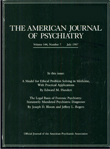Quantitative Morphology of the Cerebellum and Fourth Ventricle in Childhood-Onset Schizophrenia
Abstract
OBJECTIVE: Studies have suggested that the maldeveloped neural circuitry producing schizophrenic symptoms may include the cerebellum. The authors found further support for this hypothesis by examining cerebellar morphology in severely ill children and adolescents with childhood-onset schizophrenia. METHOD: Anatomic brain scans were acquired with a 1.5-T magnetic resonance imaging scanner for 24 patients (mean age=14.1 years, SD=2.2) with onset of schizophrenia by age 12 (mean age at onset=10.0 years, SD=1.9) and 52 healthy children. Volumes of the vermis, inferior posterior lobe, fourth ventricle, and total cerebellum and the midsagittal area of the vermis were measured manually. RESULTS: After adjustment for total cerebral volume, the volume of the vermis and the midsagittal area and volume of the inferior posterior lobe remained significantly smaller in the schizophrenic patients. There was no group difference in total cerebellar or fourth ventricle volume. CONCLUSIONS: These findings are consistent with observations of small vermal size in adult schizophrenia and provide further support for abnormal cerebellar function in childhood- and adult-onset schizophrenia. (Am J Psychiatry 1997; 154:1663–1669)



